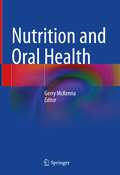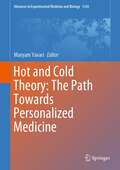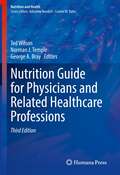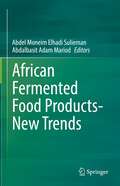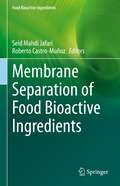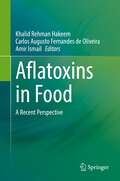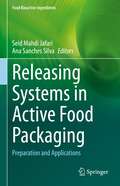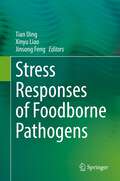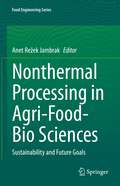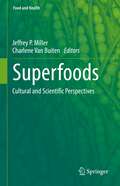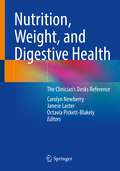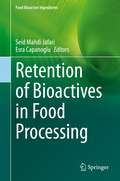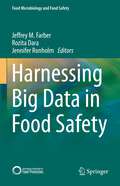- Table View
- List View
Functionality of Cyclodextrins in Encapsulation for Food Applications
by Thao M. Ho Hidefumi Yoshii Keiji Terao Bhesh R. BhandariCyclodextrins (CD) are cyclic oligosaccharides containing 6, 7 or 8 glucose units (α, β or γ-CD, respectively) in a truncated molecular shape. Their cyclic molecular structure contains a hydrophilic surface and a hydrophobic cavity at the center that can interact (host) with external hydrophobic compounds (guest molecules). Cyclodextrins have been categorized as Generally Recognized As Safe (GRAS) in the USA, “natural products” in Japan, and as “novel food” in Australia, New Zealand and EU countries. They are therefore widely used in food production to encapsulate hydrophobic compounds, including solid, liquid and gas molecules, in order to solubilize, stabilize or control the release rate of these components. To date, there has been no comprehensive review of the very large number of studies performed on encapsulation using cyclodextrin powders for food applications in recent years. This text fills that gap for academics in the encapsulation field and for industry professionals who want to gain a solid understanding of encapsulation functionality of cyclodextrin powders. The book consists of 16 chapters in which chapter 1 introduces cyclodextrin properties and its applications in food processing, and chapters 2-16 explore applications of cyclodextrin in encapsulation for many guest compounds. These compounds include gases, flavors, colors, pigments, polyphenols (plant bioactive compounds), essential oils, lipids (cholesterol and polyunsaturated fatty acids), vitamins, fruit ripening controlling compounds, and antifungal and antimicrobial compounds. These chapters also discuss functionalities of cyclodextrin in packaging, masking off-flavor and off-taste, and as dietary fiber. Covering a broad range of cyclodextrin applications and suitable for both newcomers to encapsulation technology and those with experience, Functionality of Cyclodextrins in Encapsulation for Food Applications is a unique and essential reference on this increasingly important topic.
Nutrition and Oral Health
by Gerry McKennaThis book explores in depth the relationships between nutrition and oral health. Oral health is an integral part of general health across the life course, and this book examines nutritional and oral health considerations from childhood through to old age, with particular attention focused on the consequences of demographic changes. Current knowledge on the consequences of poor diet for the development and integrity of the oral cavity, tooth loss, and the progression of oral diseases is thoroughly reviewed. Likewise, the importance of maintenance of a disease-free and functional dentition for nutritional well-being at all stages of life is explained. Evidence regarding the impact of oral rehabilitation on nutritional status is evaluated, and strategies for changing dietary behaviour in order to promote oral health are described. Nutrition and Oral Health will be an ideal source of information for all who are seeking a clearly written update on the subject.
Hot and Cold Theory: The Path Towards Personalized Medicine (Advances in Experimental Medicine and Biology #1343)
by Maryam YavariThis book is about the theory of Hot and Cold, a mutual fundamental base of traditional medicines all around the world. The theory describes the dynamic balance state of the body on the axis of hot and cold for each individual and proposes the fact that deviation from this equilibrium is a predisposing factor for diseases. Such an approach helps practitioners to provide treatments tailored to the patient’s condition, not the disease. This book, for the first time, has gathered native descriptions of Hot and Cold theory in different traditional medicines, including traditional Chinese medicine, Persian (Humoral, Unani) medicine, Ayurvedic medicine and Latin American and Caribbean medicines. After defining the common ground, contemporary research - in nutrition, pharmacology, physiology and systems biology - has been explored using scientific methodology. This work is the result of an international collaboration of more than 30 scientists and scholars with high reputations in their fields. Hot and Cold theory, as a holistic individualized approach in prevention, diagnosis and treatment, can be merged into the novel fast-paced concepts in systems biology and precision medicine. Through this bridge, the authors propose that the Hot and Cold theory should be revisited more deeply by medical scientists, who are the main audience of this book, to pave the way towards integrated holistic personalized medicine.
Phoma: Diversity, Taxonomy, Bioactivities, and Nanotechnology
by Mahendra Rai Beata Zimowska György János KövicsThe book covers the taxonomy, diversity, bioactivity, and nanotechnology involved in the study of the genus Phoma. It presents the most recent molecular taxonomic approach, secondary metabolites, different bioactivities, combating microbial threats, and its use in nanotechnology from a basic research to an applied perspective. Expert contributors provide the latest research and applications to present thorough coverage of this important genus in human and plant pathology and the disease management.
Integrative Geriatric Nutrition: A Practitioner’s Guide to Dietary Approaches for Older Adults
by Julie Wendt Colleen Considine Mikhail KoganThis book provides a review of therapeutic foods and diets for aging patients. Drawing from extensive clinical experience in large integrative medical practices, it offers a unique and thorough perspective on the challenges that older adults present and the most effective ways to integrate nutritional approaches into their care. Nutritional therapies included here improve patient quality of life via noninvasive, lower cost care and reduce systemic dependencies in a growing demographic. This book looks at condition-specific interventions to equip the practitioner with a thorough understanding of when to call upon specific diet interventions. The text revolves around easily translated clinical tools such as tables, graphs, case studies, and examples to assure multicultural adaptation of evidence-based approaches for conventional use in clinical settings. Integrative Geriatric Nutrition: A Practitioner’s Guide to Dietary Approaches for Older Adults is a concise yet thorough resource for all physicians and medical students who treat aging patients, including geriatricians, nutritionists, family physicians, gastroenterologists, nursing home administrators, nurses, other healthcare providers, geriatric advocates, and inquisitive consumers.
Nutrition Guide for Physicians and Related Healthcare Professions (Nutrition and Health)
by Norman J. Temple George A. Bray Ted WilsonThis fully updated and expanded third edition is a reference guide on nutrition and its clinical implications for health and disease through the life-cycle. The book endeavors to address the needs of those who would most benefit from up-to-date information on recent advances in the field of nutrition. Written by experts in the field, chapters cover a diverse range of nutritional areas that present a succinct overview of recent thinking and discoveries that have the greatest capacity to aid physicians and other healthcare professionals in improving the nutritional health of their clients. The text is divided into eight parts. Part one and two address the nutrient requirements and special nutrition-related issues for people across all stages of the lifespan—from pregnancy and infancy through the adolescent years to the older adult years. Part three summarizes the role of nutrition in the prevention and management of chronic conditions frequently seen in clinical practice, including obesity, diabetes, bone disorders, coronary heart disease, hypertension, and cancer. Part four describes different dietary patterns (the Mediterranean diet, the DASH diet, the vegetarian diet, and the ketogenic diet). Part five describes nutrition challenges specific to surgery and several different acute diseases and disorders (gastrointestinal disorders, food allergy and intolerance, diseases of the liver and pancreas, kidney disease, eating disorders, bariatric surgery, sarcopenia, and drug interactions with food). Part six looks at different aspects of the diet (coffee, tea, dietary fat, dietary sugars, energy drinks, alcohol, dietary fiber, vitamins, minerals, and the gut microbiome). Part seven examines a range of factors that influence dietary health decisions (creating nutritional behavior change, methods for assessing nutritional status, Dietary Reference Intakes, an overview of the diet and food guides, food labels, and sources of nutrients). Finally, part eight looks at dietary supplements (including the problem of dishonest marketing) and false and misleading information in the area of nutrition. The growing nutritional impact of COVID-19 is discussed throughout the book where appropriate.Nutrition Guide for Physicians and Related Healthcare Professions Third Edition serves as a comprehensive guide that is organized by age/lifespan, nutrition therapy in relation to chronic disease and COVID, diet and its role in prevention, dietary requirements and recommendations, and influencing health decisions for the patient. It is a valuable resource of practical and easy-to-access information on nutrition for physicians, nurses, pharmacists, and others in their daily practice.
African Fermented Food Products- New Trends
by Abdalbasit Adam Mariod Abdel Moneim Elhadi SuliemanFermented foods play a major role in human nutrition and health, given the addition of flavor, improvement of texture, preservation against spoilage, and ease of digestion due to the fermentation process. This book provides information about the chemistry and bioactive compounds of African fermented food products, including their nutritional value and minor constituents. Chapters cover a wide range of topics, from the microorganisms involved in spontaneous fermentation to food safety considerations and quality assessment. The text can be used as a practical manual to better understand the nutritional and medicinal uses of various African fermented foods, as well as prepare recipes and product labels.
Membrane Separation of Food Bioactive Ingredients (Food Bioactive Ingredients)
by Seid Mahdi Jafari Roberto Castro-MuñozThis book covers current developments in membrane-based technologies for the successful recovery of food bioactive ingredients and molecules. Chapters explore emerging technologies, such as microfiltration, ultrafiltration, nanofiltration, and membrane distillation, for the selective concentration and food ingredients from food by-products, as well as techniques, such as pervaporation, for the selective separation and recovery of aroma compounds. The text provides one of the first examinations of other membrane-based technologies, such as liquid membranes (microemulsions), membrane distillation (MD) and pervaporation (PV), as thermal driven membrane processes. The separation of metabolites from microalgae and fermentation broths using membrane technologies is also covered. Researchers in food science, pharmaceutics and biotechnology looking to stay up-to-date on bioactive recovery, as well as membranologists exploring new applications for membrane-based technologies, will find this text a useful resource.
Introduction to Food Chemistry
by Vassilis KontogiorgosThe complexity of food chemistry makes it a challenging subject for students studying in a food science course. Although there are excellent food chemistry books available in the market they have two major flaws: they are either encyclopedic or they are not pitched correctly to undergraduate food science students. The first problem creates difficulties for students to identify what is important and how much they need to know. The second problem arises when the book is written by authors that are not food scientists (e.g., chemists), they are not academics that are engaged with teaching or they are not sufficiently qualified to teach. In this case, it is difficult to find links between the chemistry of foods and its relevance to applications or, quite frequently, future employment prospects of the student. Introduction to Food Chemistry bridges this gap in the relevant literature, as it employs the latest pedagogical theories in textbook writing to present the subject to students with broad range of cognitive skills. This book presents specific learning objectives for each chapter and is self-contained so students will not need to search for essential information outside the textbook. To support learning, the book has:Didactic elements with information being conveyed with 3D-figures, color-coded schemes and graphs, annotations on figures that link it to the text descriptionsBuilt-in pedagogy and learning activities at the end of each chapter that are linked to the learning objectives.Keywords and concepts for online search to instigate curiosity for further studies.Conversational writing style without losing academic rigorTo support lecturers, the book has:Helps focus teaching preparation on key aspects of food chemistry relevant to both industry and modern research.Aids the preparation of exams, assignments and other types of assessment or learning activities.For lecturers in search of a singular source to aid in their introductory food chemistry courses, look no further than Introduction to Food Chemistry.
Aflatoxins in Food: A Recent Perspective
by Khalid Rehman Hakeem Carlos A. F. Oliveira Amir IsmailMycotoxins are the metabolites of fungus and are reported to contaminate nearly 25% of the food produced worldwide. The mycotoxins of most significance are the aflatoxins due to their severe health implications and their prevalence in food commodities on a larger scale. Aflatoxins are produced by certain species of fungi the most prominent among which are Aspergillus flavus, A. parasiticus and A. nominous. Food commodities of African and South Asian countries are especially reported to have aflatoxins well beyond the allowable limits but due to the global trade of food commodities developed countries are also prone towards the perils of aflatoxins. Moreover, climate changes may have a substantial impact on the distribution and global prevalence of aflatoxins in the near future.The International Agency for Research on Cancer (IARC) has classified the aflatoxins as group 1 category carcinogen. Aflatoxins are also reported as teratogenic, mutagenic, growth retardant, immunosuppressant and may also cause nervous system and reproductive system disorders. Preventive approaches involving good manufacturing from “farm to fork” are the major focus of the current food industry.The aim of our book is to provide readers with the most recent data and up-to-date studies from aflatoxins research, with specific focuses on (i) the impact of aflatoxins on human health, (ii) new approaches by the researchers from different parts of the world to degrade aflatoxins and (iii) potential preventive approaches that can significantly lessen the burden of aflatoxins in food products
Proceedings of ICEPP 2021: Efficient Production and Processing (Lecture Notes in Civil Engineering #190)
by Yury VankovThis book gathers the latest advances, innovations, and applications in the field of environmental and construction engineering, as presented by international researchers and engineers at the 2nd International Conference on Efficient Production and Processing, held on February 25-26, 2021. It covers highly diverse topics, including use of secondary raw materials in construction technologies; urban waste management logistics; use of recycled materials in road construction; safety and security in waste handling; food science and agriculture; waste and water treatment; and environmental economics. The contributions, which were selected by means of a rigorous international peer-review process, highlight numerous exciting ideas that will spur novel research directions and foster multidisciplinary collaborations.
Microbial Biocontrol: Volume 2
by Ajay KumarThis second volume of a two-volume work reviews beneficial bioactive compounds from various microorganisms such as bacteria, fungi, cyanobacteria in plant diseases management and the postharvest management of fruits using microbial antagonists. Furthermore, it reviews the impact of climate change on food security and addressed the legal aspects of microbial biocontrol applications. The two-volume work “Microbial Biocontrol” introduces to mechanisms of plant-microbe interactions and explores latest strategies of how microbes can be applied in biocontrol and management of plant pathogens, replacing chemical fertilizers and pesticides. The book covers different groups of microorganisms such as bacteria, fungi, but also the interplay of entire microbiomes, and reviews their specific benefits in crop growth promotion, in enhancing the plants’ tolerance against biotic and abiotic stress as well as in post-harvest management of various plant diseases. Novel tools such as CRISPR/Cas9 and microbe derived nanoparticles are also addressed besides the legal aspects of biocontrol applications. Today, rising global population and changing climatic conditions emerge as a major challenge for agronomist farmers and researchers in fulfilling the requirements of global food production. The conventional agricultural practices utilize undistributed use of chemical fertilizers and pesticides to enhance growth and yield of agricultural products and fresh foods, but their extensive and continuous use have led to a range of negative consequences on the food quality and safety, to environment as well as to human and animal health. Microbial biocontrol applications are presented as a solution, paving the way to a sustainable agriculture in compliance with the UN Sustainable Development Goals (SDG). The book addresses researchers in academia and agriculture.
Microbial Biocontrol: Volume 1
by Ajay KumarThis first volume of a two-volume work presents the manifold applications of beneficial microbes and microbiomes in plant growth promotion, in enhancing crop resilience and in control of phytopathogens through microbial antagonists. In-depth insights into latest technologies such as biopriming of seeds and soil inoculation of rhizosphere microorganisms are provided.The two-volume work “Microbial Biocontrol” introduces mechanisms of plant-microbe interactions and explores latest strategies of how microbes can be applied in biocontrol and management of plant pathogens, replacing chemical fertilizers and pesticides. The book covers different groups of microorganisms such as bacteria, fungi, but also the interplay of entire microbiomes, and reviews their specific benefits in crop growth promotion, in enhancing the plants’ tolerance against biotic and abiotic stress as well as in post-harvest management of various plant diseases. Novel tools such as CRISPR/Cas9 and microbe derived nanoparticles are also addressed besides the legal aspects of biocontrol applications.Today, rising global population and changing climatic conditions emerge as a major challenge for agronomist farmers and researchers in fulfilling the requirements of global food production. The conventional agricultural practices utilize undistributed use of chemical fertilizers and pesticides to enhance growth and yield of agricultural products and fresh foods, but their extensive and continuous use have led to a range of negative consequences on the food quality and safety, to environment as well as to human and animal health. Microbial biocontrol applications are presented as a solution, paving the way to a sustainable agriculture in compliance with the UN Sustainable Development Goals (SDG). The book addresses researchers in academia and agriculture.
Physicochemical and Enzymatic Modification of Gums: Synthesis, Characterization and Application
by Amin Mousavi Khaneghah Hadi Hashemi Gahruie Mohammad Hadi Eskandari Fatemeh GhiasiNatural gums are polysaccharides consisting of multiple sugar units linked together via glycosidic linkages. Most natural gums reveal appropriate safety for oral consumption in the form of food additives or drug carriers. Challenges related to the utilization of natural polysaccharides, however, include uncontrolled rates of hydration, pH dependent solubility, viscosity reduction during storage, and weak interfacial properties. Modification provides an efficient route for not only removing such drawbacks but also improving physicochemical properties, such as solubility, viscosity and swelling index, and introducing new properties for varied applications.This book provides a comprehensive review of the various modifications on gums to make them suitable for food, cosmetic and pharmaceutical industries. The book is divided in four parts: an introduction to natural gums followed by in-depth coverage of chemical modification, physical modification, and enzymatic modification of gums. Each chapter includes reaction mechanisms, physicochemical properties, rheological properties, interfacial properties, applications and future perspectives. Presenting a succinct account on gum modification from a practical point of view, this book is a helpful reference for academic and industrial scientists and engineers in food technology, materials chemistry, pharmaceuticals, chemical, industrial, and applied engineering, biochemistry, and biopolymers.
Denis Burkitt: A Cancer, the Virus, and the Prevention of Man-Made Diseases (Springer Biographies)
by John H. CummingsThis biography of Dr. Denis Parsons Burkitt, after whom the childhood cancer Burkitt's lymphoma was named, and who was a pioneer of the dietary fiber movement, paints a personal but holistic portrait of both the man and his life's work. Featuring excerpts from Dr. Burkitt's personal diaries, spanning seven decades from his boyhood to just before his passing, and extensive family archives, this book invites readers to follow Burkitt's journey through life and experience his tribulations and successes. Prof. John Cummings was a colleague of Dr. Burkitt and weaves the tale of his life through the lens of family, faith, and science. The journey takes Burkitt from his childhood in Ireland, a country undergoing major social upheaval, through his medical studies in Dublin, to army service in Africa in the midst of WWII and the independence movements that swept the continent in the following years. During his two decades spent in Uganda, working for the Colonial Medical Service, Burkitt made his first major contribution to cancer research - the characterization of Burkitt's lymphoma and its possible viral cause. Following his return to England in 1966, he turned his attention to the cause of ‘Western Diseases’ especially the role of dietary fibre in the prevention of disease and promotion of health. This earned him even wider international recognition and helped to inspire what is a vital field of research today. The book examines Burkitt's personal views of the world around him, including his experiences as a committed evangelical Christian who had been raised an Irish Protestant, and the challenges, both familial and cultural, that this elicited from and towards him and his scientific work. The lymphoma and later the fibre story propelled Denis into an orbit of worldwide travel, fame and many honours. An engaging speaker but man of great humility, always giving the credit for much of what he did to others, he left a legacy of evidence and ideas for the causes of cancer and prevention of disease from which we all now benefit.
Releasing Systems in Active Food Packaging: Preparation and Applications (Food Bioactive Ingredients)
by Seid Mahdi Jafari Ana Sanches SilvaValuable progress has been made in food packaging over the past two decades, reflecting advancements in process efficiency, improved safety and quality throughout the supply chain, and the need to reduce product loss and environmental impact. A new generation of food packaging systems, including active and intelligent packaging, is emerging, based on technological breakthroughs that offer the possibility of extending shelf-life, reducing food loss, and monitoring changes in the food product. Releasing Systems in Active Food Packaging closely examines such a technological breakthrough, active releasing systems, which add compounds such as antimicrobials, antioxidants, flavors, colorants, and other ingredients to packaged food products. Chapters detail examples of recent innovations in active releasing systems, and the authors systematically address their application to different food groups. Such an in-depth approach makes this a useful reference researchers, health professionals, and food and packaging industry professionals interesting in innovative food packaging technologies.
Stress Responses of Foodborne Pathogens
by Tian Ding Xinyu Liao Jinsong FengFood-borne bacterial pathogens encounter a number of stressors during food processing and preservation. More and more pathogens are able to adapt their physiological properties and/or genetic expression to survive these stressors and pose a risk to food safety and public health. This book provides the reader with a comprehensive overview of common food processing-associated stressors (e.g., heat, cold, acid, osmosis, and oxidation) and deals with the molecular basis of the respective bacterial stress response mechanisms (e.g., viable but nonculturable state, biofilm formation, sporulation, and cross-protection response). Additionally, various chapters cover the response mechanisms of foodborne pathogens to emerging nonthermal sterilisation technologies such as ultrasound, high-pressure processing, pulsed electric fields, ultraviolet light, irradiation and phytochemicals. Through this book we also learn about future prospects for the efficient control of stress adaption in foodborne pathogens to ensure maximum consumer safety. This book offers a valuable resource for researchers, graduate students, food process engineers and product developers in the fields of food science and microbiology.
Nonthermal Processing in Agri-Food-Bio Sciences: Sustainability and Future Goals (Food Engineering Series)
by Anet Režek JambrakThis book addresses important questions on the legislation, regulations, sustainability, technology transfer, safety of biomaterials and mechanism of action of nonthermal processing on the molecular level of biomaterials and its impact on health. The chapters take an interdisciplinary approach that is of interest to specialists from engineering, physics, chemistry, agriculture, life sciences and beyond, with a focus on further development of existing and new applications of nonthermal processing and their combination with other methods in the processing of biomaterials, agriculture, biotechnology and the re-use of waste and by-products. Nonthermal Processing in Agri-Food-Bio Sciences: Sustainability and Future Goals aims to boost further developments and applications of nonthermal technologies to develop healthier products, to ensure consumer approval for these innovative technologies and to improve the sustainability of biomaterials production.The industrial application of nonthermal processing has led to an increase in innovative value products and the overall improvement of production capacity. Nonthermal processes use less energy and chemicals, reduce processing times, have less environmental impact, produce less waste, and have the potential for industrial scale-up and a return-on-investment in under 5 years. According to The United Nations and the 2030 Agenda for Sustainable Development, 17 goals should be incorporated within development projects, and researchers are starting to use novel techniques to meet them. In covering the fundamental engineering theories underlying nonthermal processing, this book will aid in this mission.The book overviews the advantages and disadvantages of novel technologies, over to sustainability goals to correct steps for the scale-up and return on investment. The book includes the chemistry and physics of nonthermal processing technologies, dedicated to specialists and researchers from a wide range of subject areas. Interdisciplinary scientists and engineers, sustainability experts can use this text to aid in their work in green technologies.
Superfoods: Cultural and Scientific Perspectives (Food and Health)
by Jeffrey P. Miller Charlene Van BuitenSuperfoods have come to the forefront of the public imagination due to a combination of presumed health benefits and cultural mystique. Much of the literature on these foods, however, is based upon rostrums and diet plans that accept the health claims of superfoods without subjecting them to rigorous scrutiny. Superfoods: Cultural and Scientific Perspectives examines these food products from a blended science and cultural viewpoint, presenting a balanced, evidence-based view of each food item. Following a discussion of “superfoods” as a category, the book’s chapters examine individual superfoods, including but not limited to: avocados, chocolate, wine, berries, and fish oil. Presented in a systemic manner, each chapter provides a cultural history of the superfood; a survey of the current state of nutritional research on the food and its health claims; an exploration of related science topics to enhance understanding of the superfood, (i.e., a survey of the botany, biology, or chemistry studies); social issues associated with the superfood, such as sustainability, environmental health concerns, agricultural issues, fair trade and marketing issues; and one to three recipes featuring the superfood. This combination of scientific and cultural perspectives makes Superfoods an invaluable reference for academics, industry professionals, and lay-readers alike.
Nutrition, Weight, and Digestive Health: The Clinician's Desk Reference
by Carolyn Newberry Janese Laster Octavia Pickett-BlakelyThis book serves as a definitive nutritional reference for medical practitioners who care for patients with digestive diseases. This first-of-its-kind title explores the critical link between nutrition and weight and digestive health and organizes the necessary information for easy use for clinicians across specialties. The book is divided into four sections; the first section outlines basic nutritional concepts that lay a foundation for future chapters. This includes discussion of the gastrointestinal tract’s role in digestion and metabolism, an outline of dietary composition and associated deficiencies, and a review of nutritional assessment and general therapeutic principles. Next, the second section outlines dietary and nutritional implications of specific digestive diseases organized by affected gastrointestinal organs. Following this, the third section discusses appetite regulation, weight management, and obesity’s association with gastrointestinal diseases. It also discusses the importance of comprehensive, multi-disciplinary obesity care including a review of dietary, pharmacological, endoscopic, and surgical options that promote weight loss. In concluding the book, the fourth section discusses foundational nutritional support concepts. Nutrition, Weight, and Digestive Health is an invaluable reference for medical practitioners seeking a title that explores important and revolutionary elements to the medical care of those with digestive diseases.
Next-Generation Plant-based Foods: Design, Production, and Properties
by David Julian McClements Lutz GrossmannThe creation of plant-based foods is one of the most rapidly advancing areas in the modern food industry. Many consumers are adopting more plant-based foods in their diets because of concerns about global warming and its devastating impacts on the environment and biodiversity. In addition, consumers are adopting plant-based diets for ethical and health reasons. As a result, many food companies are developing plant-based analogs of animal-based foods like dairy, egg, meat, and seafood products. This is extremely challenging because of the complex structure and composition of these animal-based foods.Next-Generation Plant-based Foods: Design, Production and Properties presents the science and technology behind the design, production, and utilization of plant-based foods. Readers will find a review of ingredients, processing operations, nutrition, quality attributes, and specific plant-based food categories such as milk and dairy products, egg and egg products, meat and seafood products, providing the fundamental knowledge required to create the next generation of healthier and more sustainable plant-based food alternatives.
Retention of Bioactives in Food Processing (Food Bioactive Ingredients)
by Seid Mahdi Jafari Esra CapanogluBioactive compounds in food, known for their positive health effects, can be lost during handling after harvest, processing and storage. While most foods are exposed to processing to increase shelf life and edibility and to ensure microbial safety, conventional processing methods may have disadvantages, such as decreasing the nutritional quality of foods, long processing times, high temperature and high energy uses. For these reasons, novel non-thermal food processing technologies (including HPP, ultrasound) and novel thermal food processing technologies (including microwave/Ohmic heating) have become widespread.This book provides a critical evaluation of the effects of conventional, novel non-thermal, and thermal food processing techniques on the retention and bioaccessibility of bioactive compounds in food materials. Within these three categories, many different processing methods are included: fermentation/germination, drying, extrusion, and modified atmosphere packaging, as well as novel technologies, such as microwave heating, ultrasound, high pressure processing, ozonation, and membrane separation processes.
Application of Nanotechnology in Food Science, Processing and Packaging
by Chukwuebuka Egbuna Jaison Jeevanandam Kingsley C. Patrick-Iwuanyanwu Eugene N. OnyeikeThis book entitled ‘Application of Nanotechnology in Food Science, Processing and Packaging’ presents up-to-date information on the emerging roles of nanotechnology in food industry, its fundamental concepts, techniques and applications. The application of nanotechnology in the food industry is an emerging area which has found tremendous use in improving food quality through the enhancement of food taste, texture, colour, and flavour. Also, its application has improved the bioavailability and target delivery of certain bioactive food ingredients through controlled release of nutrients, a feature that is impossible with the conventional methods of food processing. The application of nanotechnology in food packaging for the detection of contaminants, pathogens, biotoxins and pesticides through nanosensor safety evaluations has led to the increase in shelf-life of products and quality assurance through the detection and monitoring of toxins. This book taps from the experience of subject experts from key institutions around the world. The users of this book will benefit greatly as the chapters were simplified and arranged carefully to aid proper understanding, consistency and continuity.
Functional Cereals and Cereal Foods: Properties, Functionality and Applications
by Sneh Punia Bangar Anil Kumar SirohaIn recent years, consumers are concentrating more on the health benefits of food in order to preserve a healthy lifestyle and therefore becoming more aware of the relationship between diet and disease. This has resulted in a gradual shift from animal-derived to plant-based meals. Functional foods have turned into one of the rapidly expanding areas of the food industry due to the increasing awareness of consumers working to prevent lethal diseases like cancer, diabetes mellitus and cardiovascular disease. Functional foods are seen as the food or food components that manifest efficiency in protecting from diseases and attaining a healthier lifestyle by administering additional benefits on human physiology and metabolic functions apart from basic nutritional requirements of the body. Cereals hold a prominent place in this new market. Cereals and cereal foods are important energy sources and many phytochemicals such as dietary fiber, resistant starch, vitamins, minerals, lignans, phytic acid and phenolic compounds that provide a variety of health benefits. Eating functional cereal foods is an easy method to increase nutrients associated with whole grains without changing eating habits. Functional Cereals and Cereal Foods: Properties, Functionality and Applications comprehensively covers the Chemistry and nutritional composition of functional cereals components, their functionality and therapeutic significance, current innovations and functional approaches in improving attributes and biofortification and quality improvement of cereal products. The different types of functional cereals and their unlimited opportunities for the production of functional foods are covered in full, including gluten-free products and all the newest cereal processing technologies. For researchers in search of a fully up-to-date look at functional cereal foods and technologies and their important place on the current market, this text provides a timely and comprehensive overview.
Harnessing Big Data in Food Safety (Food Microbiology and Food Safety)
by Jeffrey M. Farber Rozita Dara Jennifer RonholmBig Data technologies have the potential to revolutionize the agriculture sector, in particular food safety and quality practices. This book is designed to provide a foundational understanding of various applications of Big Data in Food Safety. Big Data requires the use of sophisticated approaches for cleaning, processing and extracting useful information to improve decision-making. The contributed volume reviews some of these approaches and algorithms in the context of real-world food safety studies. Food safety and quality related data are being generated in large volumes and from a variety of sources such as farms, processors, retailers, government organizations, and other industries. The editors have included examples of how big data can be used in the fields of bacteriology, virology and mycology to improve food safety. Additional chapters detail how the big data sources are aggregated and used in food safety and quality areas such as food spoilage and quality deterioration along the supply chain, food supply chain traceability, as well as policy and regulations. The volume also contains solutions to address standardization, data interoperability, and other data governance and data related technical challenges. Furthermore, this volume discusses how the application of machine-learning has successfully improved the speed and/or accuracy of many processes in the food supply chain, and also discusses some of the inherent challenges. Included in this volume as well is a practical example of the digital transformation that happened in Dubai, with a particular emphasis on how data is enabling better decision-making in food safety. To complete this volume, researchers discuss how although big data is and will continue to be a major disruptor in the area of food safety, it also raises some important questions with regards to issues such as security/privacy, data control and data governance, all of which must be carefully considered by governments and law makers.

